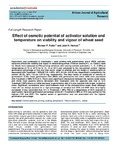Effect of osmotic potential of activator solution and temperature on viability and vigour of wheat seed
| dc.contributor.author | Fuller, MP | |
| dc.contributor.author | Hamza, J | |
| dc.date.accessioned | 2013-06-12T20:59:18Z | |
| dc.date.accessioned | 2013-06-12T20:59:49Z | |
| dc.date.accessioned | 2013-06-12T21:00:50Z | |
| dc.date.available | 2013-06-12T20:59:18Z | |
| dc.date.available | 2013-06-12T20:59:49Z | |
| dc.date.available | 2013-06-12T21:00:50Z | |
| dc.date.issued | 2013-06-28 | |
| dc.identifier.uri | http://hdl.handle.net/10026.1/1511 | |
| dc.description.abstract |
Experiment was conducted to investigate if seed priming with polyethylene glycol (PEG) activator solutions affects the viability and vigour of deteriorating wheat (Triticum aestivum L. cv. Caxton) seed lot. Seeds were subjected to PEG priming solutions with varying osmotic potentials (-1, -2, -3 MPa) at temperatures of 15 or 20°C for 6, 12, 18 or 24 h and compared to the non-primed control. Highest germination percentage at first and final count, length of plumule and dry weight of seedling were all associated with Treatment 1 MPa/20°C/6 h (92%, 94%, 9.2 cm, 0.0133 mg, respectively) compared to the control (82.5%, 86%, 7.8 cm, 0.0112 mg, respectively). The best values of coefficient of velocity of germination (CVG), mean germination time (MGT) and germination rate index (GRI) were associated with Treatment 2 MPa/15°C/24 h. There were significant interactions between the factors under study and whilst most positive effects decreased with incubation time the opposite was true at 15°C Treatment 2 MPa where an initial decrease in germination after 6 h was restored with longer incubation times. Significant correlations were found between most of the characteristics under study although these did not always account for a high percentage of variation but CVG and MGT were very highly correlated. It was concluded that, 6 h in Treatment 1 MPa PEG at a temperature of 20°C resulted in significantly improved germination percentage whilst 24 h Treatment 2 MPa at 15°C was optimal for the highest CVG and MGT. The highest speed of germination was not associated with the highest germination percentage. | |
| dc.language.iso | en | |
| dc.relation.replaces | http://hdl.handle.net/10026.1/1509 | |
| dc.relation.replaces | 10026.1/1509 | |
| dc.relation.replaces | http://hdl.handle.net/10026.1/1510 | |
| dc.relation.replaces | 10026.1/1510 | |
| dc.title | Effect of osmotic potential of activator solution and temperature on viability and vigour of wheat seed | |
| dc.type | journal-article | |
| dc.type | Article | |
| plymouth.journal | African Journal of Agricultural Research | |
| dc.identifier.doi | 10.5897/AJAR20xx.xxx | |
| plymouth.organisational-group | /Plymouth | |
| plymouth.organisational-group | /Plymouth/Faculty of Science and Engineering | |
| plymouth.organisational-group | /Plymouth/REF 2021 Researchers by UoA | |
| plymouth.organisational-group | /Plymouth/REF 2021 Researchers by UoA/UoA06 Agriculture, Veterinary and Food Science | |
| plymouth.organisational-group | /Plymouth/Users by role | |
| plymouth.organisational-group | /Plymouth/Users by role/Academics | |
| dc.rights.embargoperiod | Not known | |
| rioxxterms.versionofrecord | 10.5897/AJAR20xx.xxx | |
| rioxxterms.licenseref.uri | http://www.rioxx.net/licenses/all-rights-reserved | |
| rioxxterms.type | Journal Article/Review |


